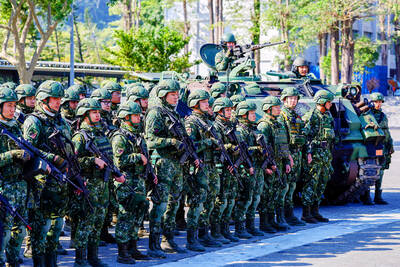In Taiwan, there is a group of doctors that cannot speak, but has helped countless children and old people heal, performing therapies that humans cannot offer, and these doctors can be referred to as “Dr dog,” Formosa Animal-Assisted Activity and Therapy Association chairman Collier Chang (張泮崇) said.
More than 500 “dog doctors” have been trained over the past two decades to provide animal-assisted therapies for people receiving rehabilitative treatment, including children and elderly people.
Speaking of Shirley Chen (陳秀宜), the founder of the association, Chang said: “Chen used to volunteer at an animal hospital overseas, where she saw dog doctors for the first time.”

Photo courtesy of Taiwan Dr. Dog Association
“Chen then introduced the training system for dog doctors in Taiwan with assistance from the Animals Asia Foundation, and founded the association in 2001,” he added.
Concerned with the rising number of abandoned dogs in Taiwan, Chen also included stray dogs in her training program, giving the animals a second chance to foster a close relationship with humans, he said.
The dog doctors’ services range from accompanying people in their everyday life to rehabilitation therapies, with services offered mainly in schools, medical institutions and care centers, said Teng Hui-chin (鄧惠津), a trainer at the association.
Being treated by a dog doctor has clear therapeutic effects, as some bed-ridden people said their mood improves when being with a therapy dog, and they would always look forward to sessions with their four-legged friends, she said.
Although some children in special education schools were at first reluctant to approach the dogs, they quickly adapted and felt comfortable, Teng said.
A woman with terminal cancer and a prognosis of only eight months to live has carried on for more than seven years and is still frequently seeing her dog doctor, she said.
Some special education teachers incorporate dog doctors into their teaching plans, boosting their students’ motivation to learn, Teng said.
For example, teachers might encourage speaking-impaired students to say the names of the dogs, or to speak to the animals, before and while they are petting the dogs, she added.
Caretakers, social workers and occupational therapists also include the dog doctors in their therapies, she said, adding that patients would comb or pet the dogs, or take them out for walks or play fetch.
Although therapies largely rely on the dog doctors’ abilities, their owners are equally important during training and therapy, she said, adding that owners facilitate interactions between dogs and humans, and their presence motivates the dogs to do their best.
The process of becoming a dog doctor can be strenuous. Before dogs can be enrolled in the three-level training courses, their aptitude and health have to be assessed. Each level of the course requires six weeks of exercises, that demand the dogs’ full attention.
Only then would the dogs be allowed to intern at therapy facilities, and only if a dog has gained enough experience, can it join the ranks of certified dog doctors, she said, adding that annual refresher courses must also be completed.
The training is not exclusive to dogs preparing for a therapeutic career, as owners who hope to learn more about their dogs’ behaviors are welcome to enroll, too, she said.

UNILATERAL MOVES: Officials have raised concerns that Beijing could try to exert economic control over Kinmen in a key development plan next year The Civil Aviation Administration (CAA) yesterday said that China has so far failed to provide any information about a new airport expected to open next year that is less than 10km from a Taiwanese airport, raising flight safety concerns. Xiamen Xiangan International Airport is only about 3km at its closest point from the islands in Kinmen County — the scene of on-off fighting during the Cold War — and construction work can be seen and heard clearly from the Taiwan side. In a written statement sent to Reuters, the CAA said that airports close to each other need detailed advanced

Tropical Storm Fung-Wong would likely strengthen into a typhoon later today as it continues moving westward across the Pacific before heading in Taiwan’s direction next week, the Central Weather Administration (CWA) said. As of 8am, Fung-Wong was about 2,190km east-southeast of Cape Oluanpi (鵝鑾鼻), Taiwan’s southernmost point, moving westward at 25kph and possibly accelerating to 31kph, CWA data showed. The tropical storm is currently over waters east of the Philippines and still far from Taiwan, CWA forecaster Tseng Chao-cheng (曾昭誠) said, adding that it could likely strengthen into a typhoon later in the day. It is forecast to reach the South China Sea

Almost a quarter of volunteer soldiers who signed up from 2021 to last year have sought early discharge, the Legislative Yuan’s Budget Center said in a report. The report said that 12,884 of 52,674 people who volunteered in the period had sought an early exit from the military, returning NT$895.96 million (US$28.86 million) to the government. In 2021, there was a 105.34 percent rise in the volunteer recruitment rate, but the number has steadily declined since then, missing recruitment targets, the Chinese-language United Daily News said, citing the report. In 2021, only 521 volunteers dropped out of the military, the report said, citing

WEATHER Typhoon forming: CWA A tropical depression is expected to form into a typhoon as early as today, the Central Weather Administration (CWA) said yesterday, adding that the storm’s path remains uncertain. Before the weekend, it would move toward the Philippines, the agency said. Some time around Monday next week, it might reach a turning point, either veering north toward waters east of Taiwan or continuing westward across the Philippines, the CWA said. Meanwhile, the eye of Typhoon Kalmaegi was 1,310km south-southeast of Oluanpi (鵝鑾鼻), Taiwan’s southernmost point, as of 2am yesterday, it said. The storm is forecast to move through central